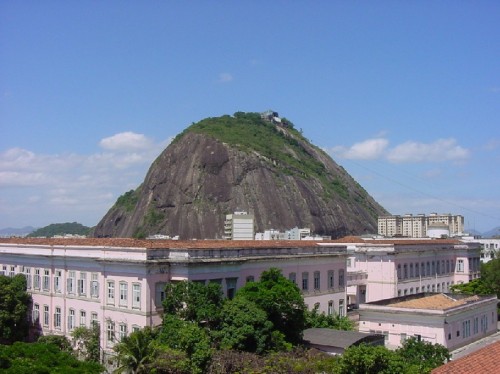
View towards the Sugar Loaf Mountain from the CBPF in Rio de Janeiro. (Courtesy: Herman Pessoa Lima)
By Matin Durrani in Rio de Janeiro
Having flown almost half-way round the world from Bristol to Rio, you might think there is little in common between Physics World‘s home city and the Brazilian metropolis.
But on my trip to the Brazilian Centre for Physics Research (CBPF) in Rio today, it soon became clear from the statistical physicist Constantino Tsallis, who hosted my visit, that there is indeed a link between the two cities. That connection lies with the Brazilian physicist César Lattes, who was the founding director of the CBPF.
As Tsallis explained to me, Lattes had worked in the late 1940s at the University of Bristol with Cecil Powell, with the pair discovering the particle known as the pi-meson. Powell went on to win the 1950 Nobel Prize for Physics, although Lattes (for some reason) missed out.
Lattes returned to Rio in 1949 to head the new CBPF, which has since gone on to become one of the top physics research institutes in Brazil (if not the best).
With views towards the cable cars climbing up and down from Morro da Urca – the hill that’s a staging point to the even higher Sugar Loaf Mountain – the CBPF is certainly a beautiful place to be a physicist, especially on a day like today with the Sun burning down. The building is also lined with old photos of physicists who’ve had links with the lab, including Richard Feynman, who made a number of lengthy visits to Brazil early in his career.
In his book Surely You’re Joking Mr Feynman!, the great theorist wrote a withering description of the problems facing physics education in Brazil, where students in the country were great at memorizing physics problems by rote, but seemed to have little practical understanding of the consequences of the things they’d learned.
But sitting in his director’s office, Fernando Lazaro – the current successor to Lattes as CBPF boss – thinks that there are still challenges for physics education in Brazil. The problem, by all accounts, lies largely with a lack of good quality physics teachers, with poor pay being a big detriment to attracting bright students into the profession. Another big issue is that it’s not possible for physicists later in their careers to retrain as teachers unless they go back and take a full four-year physics-teaching degree. That’s surely shutting the door to potential recruits.
As Lazaro explained to me, he can teach 18-year-old students doing a physics degree, but it would actually be illegal for him to teach physics to the same 18-year-old students at high school in the weeks before they go to university.
Surely you’re joking Professor Lazaro?
Well this is the irony for the developing nations around the world. Most countries have had laws to hinder the actual progress of sciences. Even those who claimed to be servants of science and their respective countries did more harm then good
Lets hope this new year starts to give to those who have not yet tasted science ….
‘the obsession of life’.
Trackback: Blog - physicsworld.com